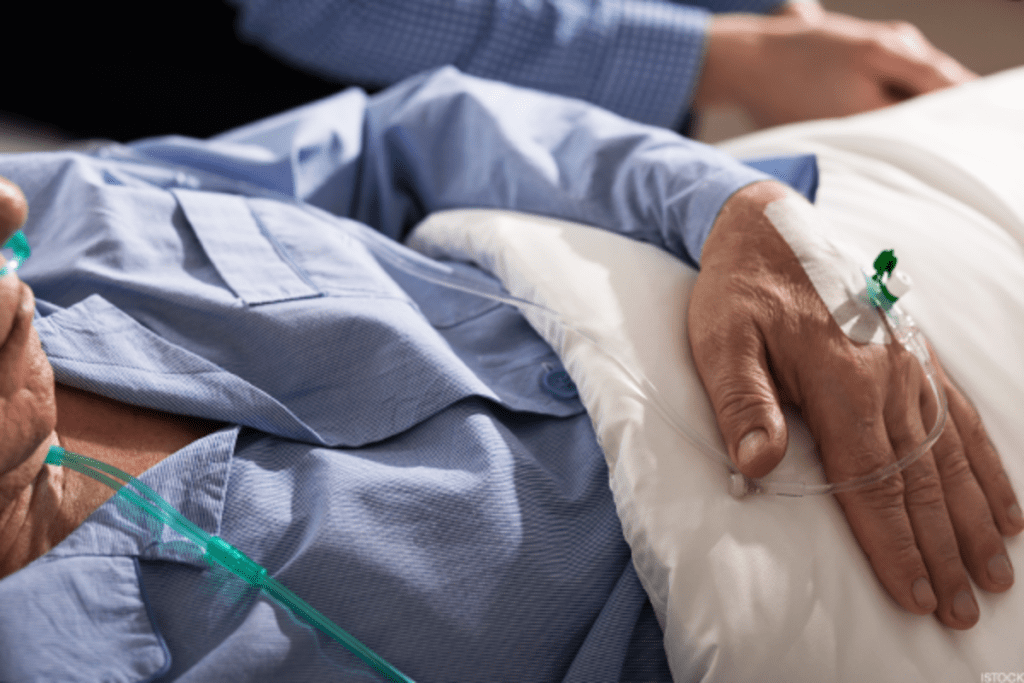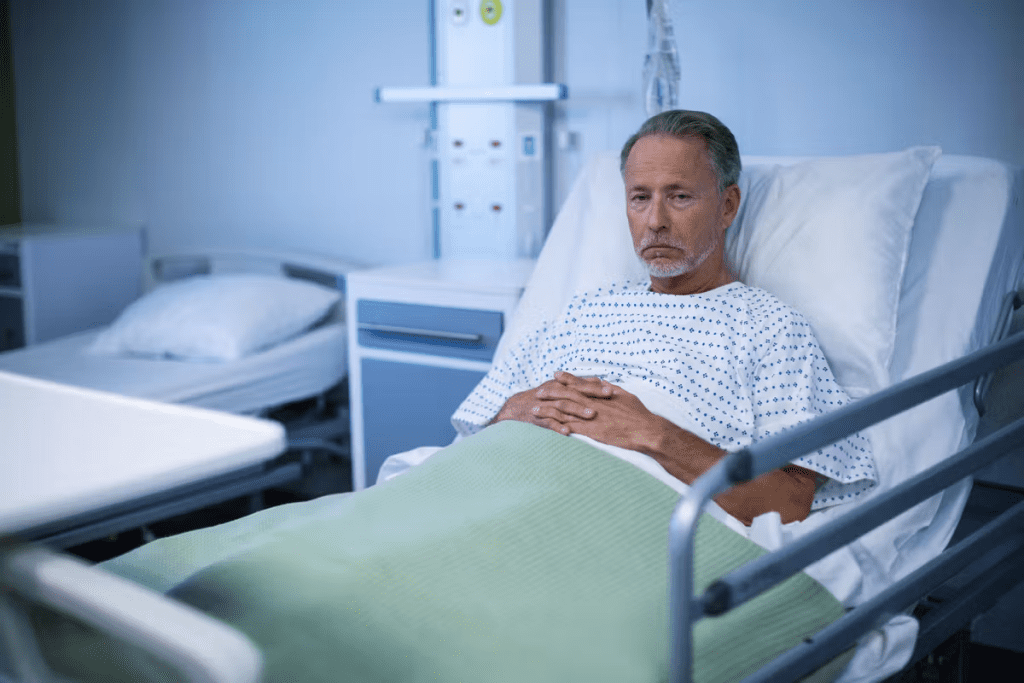Last Updated on November 26, 2025 by Bilal Hasdemir

Cancer treatment is complex and personalized for each patient. Even with advances in medical technology, chemotherapy remains a key treatment for many cancers. However, it doesn’t work for everyone.
Many cancer patients undergoing chemotherapy experience varied results. Some achieve full recovery, while others don’t respond as well. For patients ” and even those who share their journeys publicly, like the well-known chemo man figures ” recognizing the signs that chemotherapy isn’t working is crucial. Spotting these signs early can help guide informed decisions on the next steps in treatment.
Key Takeaways
- Chemotherapy effectiveness varies among patients.
- Some cancer patients may not respond well to chemotherapy.
- Understanding signs of chemotherapy failure is key.
- Recognizing these signs helps in making informed treatment decisions.
- Cancer treatment is highly individualized.
Understanding Chemotherapy and Its Expected Outcomes

It’s important for patients to know how chemotherapy works. This treatment uses drugs to kill or stop cancer cells from growing.
How Chemotherapy Targets Cancer Cells
Chemotherapy targets cells that grow fast, like most cancer cells. It stops these cells from dividing. Cancer cells divide quickly, making them more vulnerable to chemotherapy. But, some healthy cells also grow fast and can get hurt, causing side effects.
Measuring Treatment Success
Doctors check how well chemotherapy is working in several ways. They use imaging tests, blood tests, and physical exams. Tumor markers in the blood also show if treatment is effective. A smaller tumor or lower tumor marker levels mean the treatment is working.
| Assessment Method | Indicators of Success |
| Imaging Tests | Reduction in tumor size |
| Blood Tests | Decrease in tumor marker levels |
| Physical Examination | Improvement in symptoms, reduction in palpable tumor size |
The Timeline for Evaluating Chemotherapy Response

Cancer treatment closely watches how chemotherapy works. It’s a detailed process that looks at many things. These include the cancer type, its stage, and the chemotherapy used.
Early Indicators of Treatment Effectiveness
Early signs that chemotherapy is working include better symptoms. For example, less pain or normal blood tumor markers. These signs mean the treatment is helping.
Tumor markers are made by cancer cells or in response to it. Blood tests track these markers. They give early hints about treatment success.
When to Expect Tumor Shrinkage
Tumor shrinkage shows chemotherapy is working well. How fast this happens varies. Some see changes in a few cycles, others take longer.
Usually, doctors check after 2-3 cycles. Imaging tests like CT scans or MRIs measure tumor size. They help see if the cancer is shrinking.
Follow-up Protocols After Treatment Cycles
After each chemotherapy cycle, patients get checked up. This includes physical exams, blood tests, and imaging. It’s to see how the cancer is reacting.
These follow-ups are custom-made for each patient. They help doctors adjust the treatment plan. This aims for the best results.
Physical Signs That May Indicate Chemotherapy Isn’t Working
Patients on chemotherapy should watch for physical signs that may mean the treatment isn’t working. Chemotherapy uses drugs to kill cancer cells. Its success can be seen by changes in symptoms and health.
Persistent or Worsening Cancer Symptoms
If symptoms like pain, fatigue, or breathing trouble don’t get better or get worse with chemotherapy, it might not be working. Keeping an eye on symptom severity is key to deciding what to do next.
New Tumor Growth or Metastasis
New tumors or cancer spreading to other parts of the body can mean chemotherapy isn’t stopping cancer growth. Regular imaging tests help catch these changes early.
Unexpected Weight Loss or Decline in Function
Unexpected weight loss or getting weaker can show chemotherapy isn’t working as planned. These changes can really affect a patient’s life quality. It’s important to talk about them with the doctor.
| Physical Signs | Possible Indications |
| Persistent or worsening cancer symptoms | Chemotherapy not effectively controlling cancer |
| New tumor growth or metastasis | Cancer progression despite treatment |
| Unexpected weight loss or decline in function | Treatment not improving or worsening overall health |
Knowing these signs can help patients and their caregivers make better treatment choices. It’s vital to talk about any concerns or changes with the healthcare team. This way, they can figure out the best next steps.
Tumor Response Indicators and Their Meaning
Doctors check how tumors react to chemotherapy to change treatment plans. This check is key to see if the current treatment works or if they need to try something else.
Complete vs. Partial Response
Tumor response is divided into types like complete and partial response. A complete response means the tumor is gone, showing the treatment worked well. A partial response shows the tumor shrunk but is not gone yet.
Knowing the difference between these responses is vital. For example, a patient with a complete response might keep the same treatment or try more therapies to prevent cancer return.
Stable Disease vs. Progressive Disease
There are also stable disease and progressive disease. Stable disease means the tumor size doesn’t change, showing the cancer isn’t getting better but not worse either. Progressive disease means the tumor is getting bigger or spreading, even with treatment.
If a patient’s disease is stable or progressive, the doctor might change the treatment plan. This could mean trying a more aggressive or different treatment.
When Tumors Don’t Shrink as Expected
Sometimes, tumors don’t shrink as hoped with chemotherapy. This could be because of the cancer type, disease stage, or treatment resistance. If this happens, the healthcare team will look at the treatment plan again.
They might suggest more tests or different treatments. It’s important to remember that not responding to chemotherapy doesn’t mean all hope is lost. It often means it’s time to try a different approach to fight the cancer.
Blood Test Results That Signal Treatment Failure
Blood tests are key in checking if chemotherapy is working. They show how the body reacts to treatment. This helps doctors plan the next steps for a patient’s care.
Rising Tumor Markers Despite Treatment
Tumor markers are substances in the blood, urine, or tissues of some cancer patients. When treatment works, these markers go down. But if they keep going up, it might mean the cancer isn’t responding to treatment.
Examples of tumor markers include:
- Prostate-specific antigen (PSA) for prostate cancer
- Carcinoembryonic antigen (CEA) for colorectal cancer
- CA-125 for ovarian cancer
Blood Count Abnormalities That Persist
Chemotherapy can harm the bone marrow, leading to blood cell problems. If these problems don’t go away, it could mean the treatment isn’t working. Or it might be too hard on the body.
Biochemical Indicators of Disease Progression
Biochemical tests show how well organs are working. They can also tell if cancer is getting worse. For example, liver tests can show if cancer has spread to the liver. Blood tests for certain enzymes or proteins can also signal cancer growth.
| Biochemical Indicator | Possible Implication |
| Elevated liver enzymes | Liver metastasis or damage |
| Abnormal protein levels | Presence of certain cancers or disease progression |
| High lactate dehydrogenase (LDH) | Tissue damage or certain cancers |
It’s important to understand these blood test results. Patients and doctors need to make informed decisions about treatment plans.
Imaging Results That Reveal Treatment Ineffectiveness
Advanced imaging technologies help doctors see if chemotherapy is working. These tools give key insights into how tumors react to treatment. This helps oncologists decide if they should keep or change the treatment plan.
What Oncologists Look for in Scans
Oncologists check for changes in tumor size, shape, and activity. CT scans and PET scans are key for checking treatment success. A smaller tumor or less activity means treatment is working well.
Progressive Disease on Imaging
If chemotherapy fails, scans might show progressive disease. This could be bigger tumors, new tumors, or cancer spreading. These signs mean the current treatment isn’t working, and new options are needed.
| Imaging Modality | Indicators of Treatment Failure | Clinical Implications |
| CT Scan | Increased tumor size or new lesions | May indicate progressive disease, necessitating a change in treatment |
| PET Scan | Increased metabolic activity | Suggests active cancer, potentially resistant to current chemotherapy |
| MRI | Tumor growth or spread | May require adjustment of treatment plan, including consideration of targeted therapies |
Understanding imaging results is key for cancer treatment planning. Oncologists use this info to create personalized treatment plans. This ensures the best care for each patient.
The Chemo Man: Specific Considerations for Male Cancer Patients
Male cancer patients face unique challenges that need special care. It’s important to understand these differences for effective treatment.
Men with cancer may have different side effects and treatment options than women. For example, prostate cancer is common in men and needs specific treatments.
Prostate Cancer Treatment Response
The response to prostate cancer treatment varies among individuals. The cancer’s stage, the patient’s health, and the tumor’s aggressiveness are key factors. They determine how well the treatment works.
Hormone Therapy Resistance in Men
Hormone therapy is a common treatment for prostate cancer. But, some men may stop responding to it over time. It’s important to understand why this happens to find new treatments.
Managing cancer treatment side effects is key to keeping quality of life. Healthcare providers work with patients to reduce these effects. They aim for the best possible outcomes.
When Your Oncologist Suggests Stopping Chemotherapy
When an oncologist suggests stopping chemotherapy, it’s a big moment for cancer patients. This choice is made after looking at how well the treatment is working and the patient’s health.
Understanding the Medical Reasoning
Oncologists look at many things before deciding to stop chemotherapy. They check if the tumor is shrinking, if new tumors are growing, and how well the patient is doing. Medical imaging and lab tests are key in this process. They help doctors see if the cancer is getting better.
Doctors weigh the good of continuing treatment against its side effects and risks. Sometimes, keeping up with aggressive treatment doesn’t help much. It might even make the patient’s life worse.
Questions to Ask About Treatment Failure
If an oncologist suggests stopping chemotherapy, it’s important to ask questions. These can help understand why this choice was made. Some questions to ask include:
- What specific factors led to the recommendation to stop chemotherapy?
- Are there alternative treatment options available?
- How will stopping chemotherapy affect my prognosis?
- What support is available for managing symptoms and improving quality of life?
Asking these questions helps patients and their families make informed choices.
Shared Decision-Making About Next Steps
Stopping chemotherapy is a team decision. It involves the patient, their family, and the healthcare team. Shared decision-making is key. It makes sure the patient’s wishes and goals are considered.
Patients should talk to their healthcare providers about their wishes. This includes life-sustaining treatments, symptom management, and palliative care. Working together helps tailor care to what the patient needs most.
What Happens When Chemotherapy Stops Working
When chemotherapy stops working, it can be tough and emotional for patients. It’s important to know what happens next to make good care choices.
Disease Progression Patterns
Cancer can grow in different ways. It can get bigger where it started or spread to other parts of the body.
When cancer spreads, it’s called metastasis. Cancer cells break off, travel through the blood or lymph, and form new tumors elsewhere. This can lead to new tumors in different areas.
Life Expectancy Considerations
Life expectancy depends on many things. These include the cancer type and stage, overall health, and how well previous treatments worked. Knowing these factors helps patients and their families make better care choices.
Managing Symptoms
Managing symptoms is key to keeping quality of life. This can include managing pain, getting the right nutrition, and other palliative care. These steps can help reduce discomfort and improve well-being.
Chemotherapy Resistance: Why Treatment Sometimes Fails
It’s important to know why chemotherapy doesn’t always work. Chemotherapy resistance is a complex issue. It can come from the tumor itself, genetic mutations, and the environment.
Biological Mechanisms of Resistance
Chemotherapy targets fast-growing cells, but cancer cells can find ways to resist. One way is through drug efflux pumps, like P-glycoprotein, which lowers the drug’s effect inside the cell. Another way is by fixing DNA damage caused by chemotherapy.
Table: Common Biological Mechanisms of Chemotherapy Resistance
| Mechanism | Description | Example |
| Drug Efflux Pumps | Proteins that pump chemotherapy drugs out of cancer cells | P-glycoprotein |
| DNA Repair Pathways | Pathways that repair DNA damage caused by chemotherapy | BRCA1 and BRCA2 genes |
| Anti-apoptotic Pathways | Pathways that inhibit programmed cell death | BCL-2 family proteins |
Cancer Types Known for Treatment Resistance
Some cancers are more resistant to chemotherapy. Pancreatic cancer is one example, due to its dense stroma and complex environment. Glioblastoma and certain leukemias also show high resistance.
Genetic Factors in Treatment Response
Genetics greatly affect how well chemotherapy works. Mutations in genes related to drug metabolism, DNA repair, and cell cycle can change treatment outcomes. For example, TP53 gene mutations are linked to poor chemotherapy response in many cancers.
Knowing these genetic factors can help tailor treatments. This could lead to better results for patients with resistant cancers.
Next Treatment Options After Failed Chemotherapy
Chemotherapy failure doesn’t mean the end of treatment. There are many other options to explore. When initial chemotherapy doesn’t work, doctors and patients work together to find the next best step.
Second-Line Chemotherapy Regimens
After initial chemotherapy fails, switching to a second-line regimen is often considered. This means using different drugs or combinations that the cancer might be more responsive to. The choice depends on the cancer type, the patient’s health, and past chemotherapy responses.
- Different Drug Combinations: Using alternative chemotherapy agents that the patient hasn’t received before.
- Dose Adjustments: Modifying the dosage or schedule of chemotherapy to improve efficacy or reduce side effects.
Targeted Therapies and Immunotherapies
Targeted therapies and immunotherapies offer new treatment options. These methods focus on specific cancer cell characteristics or boost the immune system’s fight against cancer.
- Targeted Therapies: Drugs designed to target specific genes or proteins that are involved in the growth and survival of cancer cells.
- Immunotherapies: Treatments that stimulate the immune system to recognize and attack cancer cells more effectively.
Clinical Trials for Treatment-Resistant Cancer
For some, clinical trials can offer access to new treatments. These trials test innovative drugs, therapies, or immunotherapies for cancers that haven’t responded to standard treatments.
- Investigational Therapies: New drugs or combinations being studied for their efficacy.
- Access to Emerging Technologies: Such as CAR-T cell therapy or other advanced immunotherapies.
Talking to an oncologist about these options can help understand the benefits and risks. It also helps determine if these treatments fit the patient’s needs and preferences.
Palliative Care When Curative Treatment Isn’t Working
Palliative care offers relief and comfort when cancer treatment fails. It aims to improve the quality of life for patients and their families.
Goals of Palliative Chemotherapy
Palliative chemotherapy aims to alleviate symptoms, manage pain, and improve well-being. It’s not about curing cancer but making life comfortable.
- Symptom control
- Pain management
- Improving quality of life
Quality vs. Quantity of Life Decisions
Deciding between quality and quantity of life is personal. Palliative care teams help patients and families make these choices.
They consider:
- Assessing symptoms and concerns
- Discussing treatment benefits and risks
- Exploring comfort-focused care options
Symptom Management Approaches
Effective symptom management is key in palliative care. It involves a team effort, including:
- Medications for pain and symptom control
- Physical therapy and supportive therapies
- Counseling and emotional support
Palliative care can greatly improve life quality for those with advanced cancer.
Emotional Impact of Failed Cancer Treatment
Failed cancer treatment can lead to a mix of emotions. You might feel disappointment and grief, or even anxiety and fear. The emotional pain can be as tough as the physical challenges. It affects not just the patient but also their family and caregivers.
Processing Disappointment and Grief
It’s key to accept the feelings of disappointment and grief when treatment fails. These emotions can be strong. You might need help from mental health experts, support groups, or loved ones.
Coping Mechanisms:
- Mindfulness and meditation
- Support groups
- Counseling or therapy
- Creative expression (art, writing, music)
Maintaining Hope While Facing Reality
It’s important to face the truth about treatment failure. Yet, keeping hope alive is also vital. You might look into new treatments, join clinical trials, or focus on palliative care to enhance your life quality.
| Approach | Description | Benefits |
| New Treatment Options | Exploring alternative therapies or clinical trials | Potential for improved outcomes, access to innovative treatments |
| Palliative Care | Focus on symptom management and quality of life | Improved comfort, reduced symptom burden |
Mental Health Support Resources
Getting mental health support is critical when dealing with the emotional fallout of failed cancer treatment. There are many resources available:
- Professional counseling
- Support groups
- Online resources and forums
- Hotlines and helplines
By recognizing the emotional impact and seeking the right support, you can handle the challenges of cancer treatment failure better.
Communicating with Your Healthcare Team
Talking to your healthcare team about cancer treatment is key. Good communication can really help your treatment work better and make your experience better too.
Having Difficult Conversations About Treatment Failure
Talking about when treatment doesn’t work can be tough. But it’s important to understand your choices. Be ready to ask why it didn’t work and what it means for your future.
Key questions to ask include:
- What were the factors that led to the treatment failure?
- Are there other treatment options available?
- What are the possible benefits and risks of these other treatments?
Advocating for Alternative Approaches
When treatment fails, you might want to try something else. This could be targeted therapies, immunotherapies, or joining clinical trials. Talk to your team about these options to see if they’re right for you.
It’s important to know why your team suggests these alternatives. Also, how they might affect your life.
When to Seek a Second Opinion
Getting a second opinion can give you new insights. It’s a good idea when you’re thinking about big changes in your treatment.
Consider seeking a second opinion if:
- You’re not sure about your diagnosis or treatment plan.
- You’re thinking about a big change in your treatment.
- You want to look at more treatment options that your current team hasn’t mentioned.
Talking well with your healthcare team is a two-way street. Share your worries, ask the right questions, and understand your choices. This helps you make smart decisions about your health.
Conclusion
It’s very important for cancer patients to know if their chemotherapy is working. They can look for signs like physical symptoms and changes in tumors. Blood tests and imaging studies also help.
If chemotherapy isn’t working, talking to your healthcare team is a must. They might suggest other treatments or clinical trials. This could be a new way to fight the cancer.
Palliative care is also important. It helps manage symptoms and improve life quality. Knowing the signs and options helps patients make better choices.
Talking openly with your oncologist is key. Together, you can create a plan that works best for you. This way, you can get the best results from your treatment.
FAQ
What are the signs that chemotherapy is not working?
Signs include persistent or worsening symptoms, new tumor growth, or metastasis. Blood tests may show rising tumor markers. Imaging tests might reveal tumors not shrinking or growing.
How long does it take to know if chemotherapy is working?
Chemotherapy’s success can be seen after 2-3 months. This is through imaging tests and tumor marker assessments.
What happens when chemotherapy stops working?
When it stops working, cancer may progress, and symptoms worsen. At this point, treatments like targeted therapy or palliative care might be considered.
Can chemotherapy fail, and what are the reasons?
Yes, it can fail for many reasons. These include resistance to drugs, inadequate dosing, or cancer stem cells resistant to treatment.
What are the alternatives to chemotherapy?
Alternatives include targeted therapy, immunotherapy, hormone therapy, and palliative care. These can be used alone or with chemotherapy.
How is the effectiveness of chemotherapy measured?
Effectiveness is measured through imaging tests like CT or MRI scans and tumor marker tests. These show if the tumor is shrinking or if cancer is progressing.
What is the role of palliative care in cancer treatment?
Palliative care relieves symptoms, pain, and stress of cancer and its treatment. It’s vital for patients with serious illnesses, including cancer.
Can you survive cancer without chemotherapy?
Yes, some can survive without chemotherapy, depending on cancer type and stage. Treatment options include surgery, radiation, or alternative therapies.
What are the side effects of chemotherapy?
Side effects include nausea, fatigue, hair loss, and changes in blood counts. Side effects vary based on the regimen and individual tolerance.
How does chemotherapy affect the immune system?
Chemotherapy weakens the immune system by reducing white blood cells. This makes it harder to fight infections.
What happens after chemotherapy is stopped?
After stopping, patients are monitored for recurrence or progression. Some may be eligible for clinical trials or other treatments.
How can I cope with the emotional impact of failed chemotherapy?
Coping with emotional impact is challenging. Seeking support from loved ones, mental health professionals, or support groups can help process emotions and adjust to the new reality.
References
- National Cancer Institute (NCI). (2023). Understanding cancer prognosis.https://www.cancer.gov/about-cancer/diagnosis-staging/prognosis






